Analysis
A Blueprint for Blue Chip: How Giacometti Became the World’s Most Expensive Sculptor
Fascination with Giacometti's elongated figures is at a fever pitch.
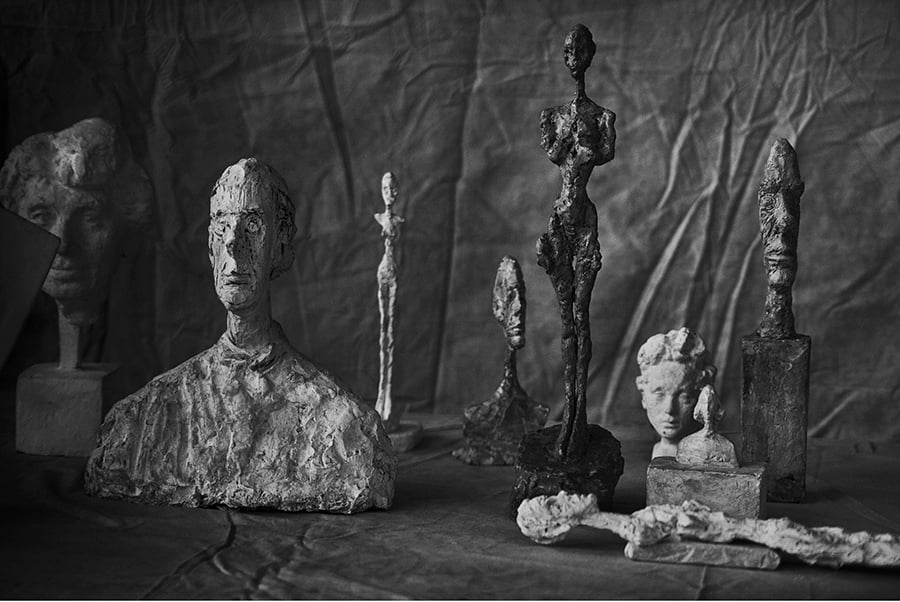
Fascination with Giacometti's elongated figures is at a fever pitch.

by
Eileen Kinsella

How do you turn an artist into a blue-chip star?
The market for the Swiss-born sculptor Alberto Giacometti (1901–1966) provides a blueprint. The artist’s international reputation and powerhouse prices are poised to grow even more this year thanks to a blockbuster exhibition at Tate Modern and the soon-to-open Institut Giacometti in Paris.
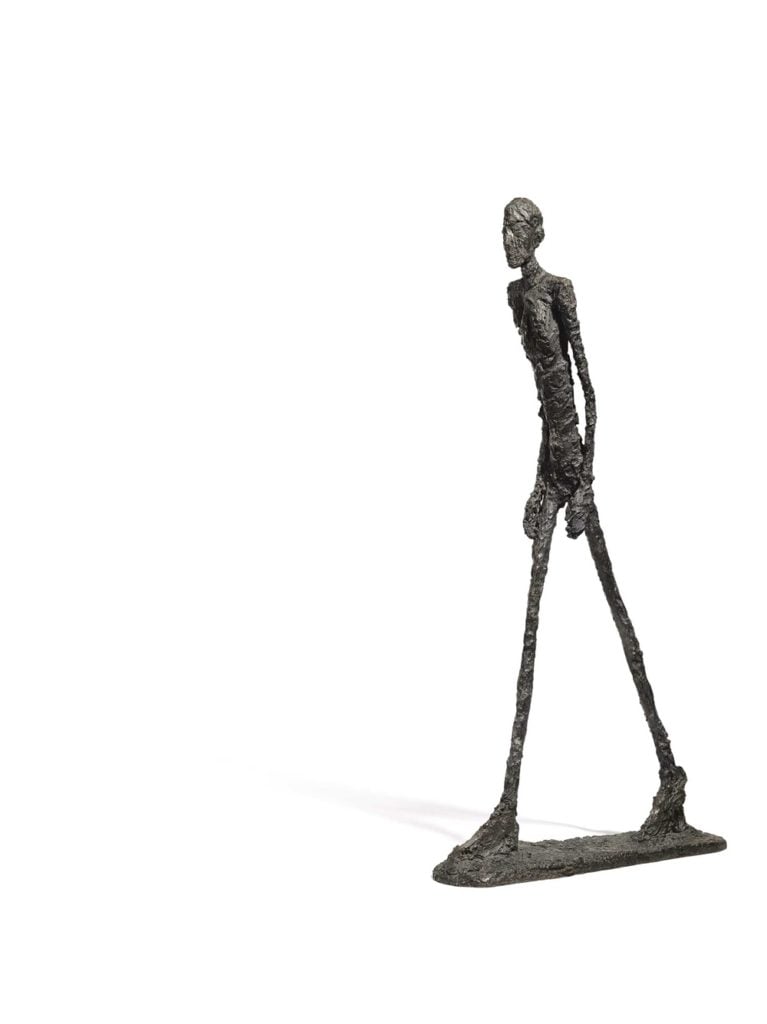
Alberto Giacometti, L’Homme qui marche I Executed in 1960 and cast in bronze in a numbered edition of 6 plus 4 artist’s proofs.
The work was cast in 1961 and is a life-time cast. Courtesy Sotheby’s.
Over the past decade, prices for the late artist’s work have skyrocketed above $100 million, making him the most expensive sculptor ever. Although his elongated figures first garnered worldwide attention and fame decades ago, he has benefited in recent years from a perfect storm of factors: smart management by the eponymous 14-year-old Paris-based foundation overseeing his legacy, the much-chronicled boom on the top end of the market, and an increasing openness on the part of collectors to shell out big money for sculpture.
Giacometti Everywhere
If you feel like you’re seeing Giacometti all over the place, you’re not alone. Last month, Tate Modern opened the first major retrospective of the artist’s work in the UK in 20 years. Meanwhile, the Swiss pavilion at the Venice Biennale is paying tribute to the artist.
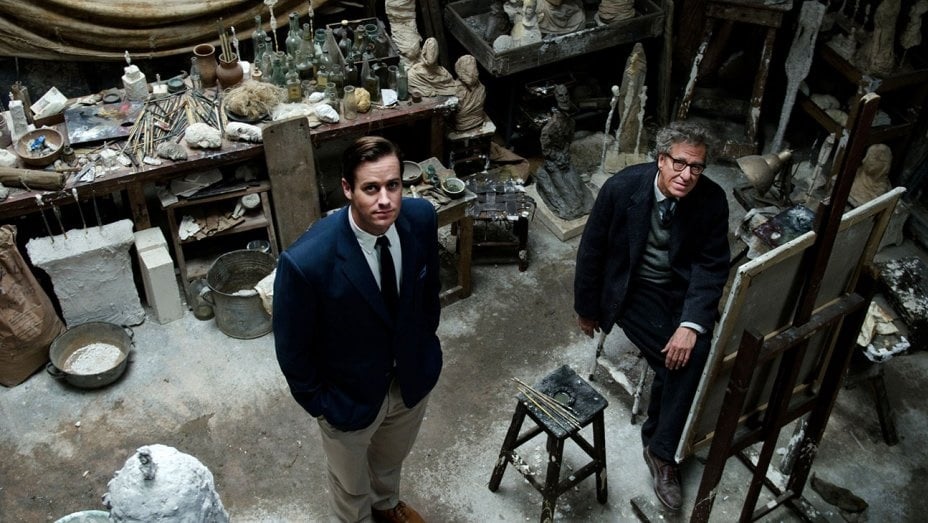
Final Portrait features Armie Hammer as James Lord and Geoffrey Rush as Alberto Giacometti.
Stanley Tucci, Final Portrait, 90′ (2017), selected by Marian Masone
A retrospective on par with that of the Tate is coming to the Guggenheim New York in 2018, artnet News has learned, and another major show at the Montreal Museum of Fine Arts is also in the works.
Gagosian Gallery’s London branch currently has a show titled “Substance and Shadow” (through July 22), which presents Giacometti sculptures alongside photos by Peter Lindbergh. Other recent shows at Shanghai’s Yuz Museum and the Qatar Museums Authority have brought the artist to new audiences.
Meanwhile, this week, actor and director Stanley Tucci is poised to unveil the biopic Final Portrait at Art Basel in Basel. The film, starring Geoffrey Rush, focuses on Giacometti’s creation of writer James Lord’s portrait in 1964, a sometimes torturous process chronicled in Lord’s book A Giacometti Portrait.
“Everyone wants a piece of him,” says Simon Stock, international director at Sotheby’s. “It’s not that there haven’t always been shows about Giacometti, it’s just incredible the amount of top quality museum shows that have been mounted globally in recent years.”
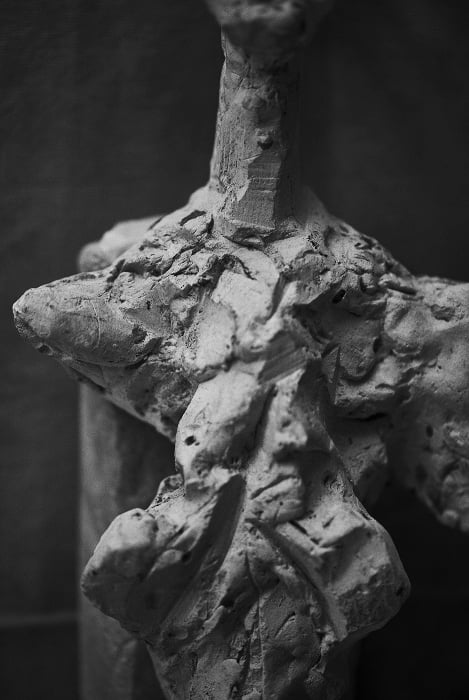
Peter Lindbergh, Alberto Giacometti, Femme debout (1961), Zurich (2016). © Peter Lindbergh © Succession Alberto Giacometti (Fondation Giacometti + ADAGP) Paris 2017.
The Foundation Pulls the Strings
The ubiquity of Giacometti can be attributed in part to the foundation’s willingness to collaborate with institutions on shows and new projects. “The foundation doesn’t have an exhibition space,” points out Mathilde Lecuyer, assistant curator at the foundation and co-curator of the Tate show. “We’re very happy to have the opportunity to do important exhibitions like this.”
The foundation also worked closely with Tucci on his film, providing archival material and detailed information that allowed the filmmakers to recreate the studio on rue Hippolyte-Maindron that Giacometti maintained for most of his life.
But things looked quite different just over a decade ago. Prior to 2003, when a singular authority was determined (the Alberto and Annette Giacometti Foundation), the artist’s legacy was clouded by controversy—including forgeries and related scandals tied to legal wrangling and competition between separate French organizations, as well as feuding between Swiss and French heirs. Most of the issues were finally resolved when Catherine Grenier, a former director of the Pompidou Centre, took the reins and experts and heirs finally decided to work together rather than battling for individual control.
The foundation also established a cordial relationship with Swiss rights owners and the Zurich-based Giacometti Stiftung and Kunsthaus, a key player with substantial holdings of the artist’s work that is now considered a sister organization.
Since then, the foundation has carefully shepherded Giacometti’s legacy by maintaining careful archives, an extensive online database and various catalogues raisonnés; offering support for museum shows; and providing authentication services. The latter, in particular, sets the foundation apart from the rest at a time when most estates and foundations have cut back on authentication for fear of being sued.
At the end of this year, the foundation will unveil the Institut Giacometti in Montparnasse, Paris, not far from where Giacometti had his longtime studio. The institute will serve as a research center and will also contain a full reconstruction of the artist’s studio, complete with his original furniture, created with help from the Giacometti library and archives.
“We want to encourage interest and research on the artist and more generally, on Modern art,” Lecuyer says. The institute will host a program of conferences, release publications, and make its archives more accessible to scholars.
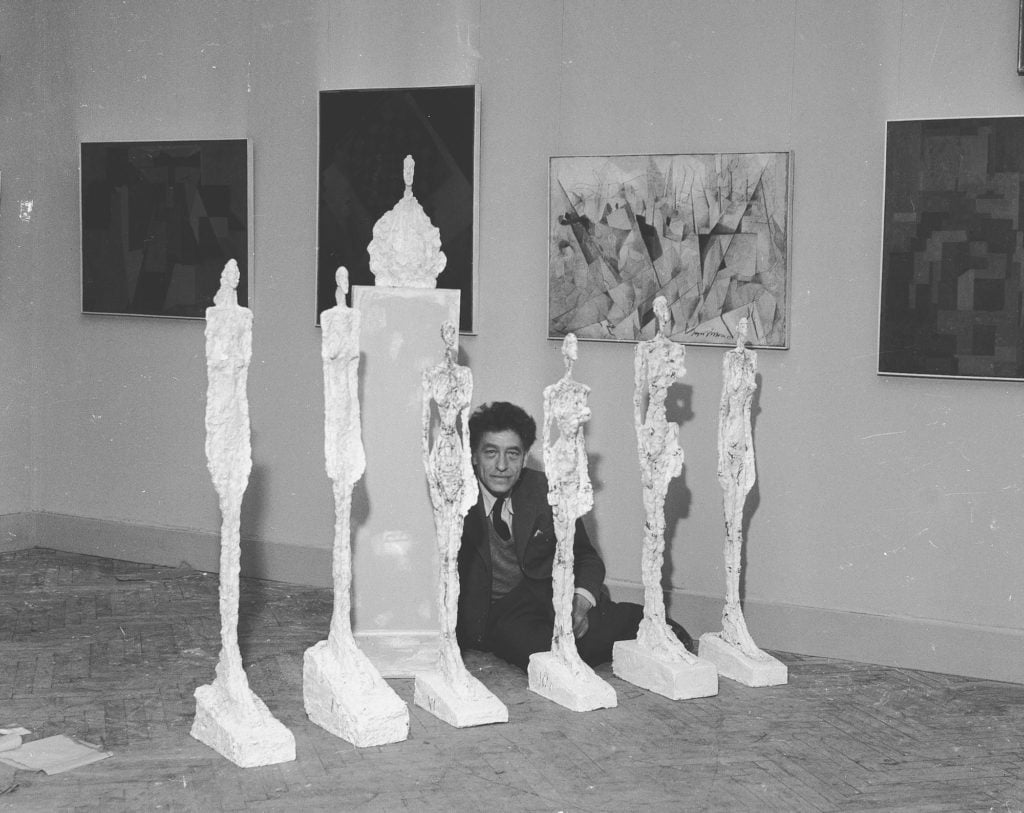
Alberto Giacometti and his sculptures at the 1956 Venice Biennale. Courtesy of the Giacometti Foundation.
Collectors Flocking
In the meantime, the foundation continues to offer its opinion on the authenticity of Giacometti works. Committee meetings can happen anywhere from five to seven times a year, “based mostly on the sales calendar,” according to Lecuyer. “And obviously the market has been rising so much in the past few years.” She says fakes “are quite easy to recognize”; the foundation also relies on its extensive archives to confirm the provenance of a particular object.
The catalogue raisonné of Giacometti’s sculptures, paintings, drawings, and decorative arts is published online as the Alberto Giacometti Database (AGD). Each work authenticated by the Comité Giacometti is given a unique AGD number. “It’s an ongoing process, and numbers are given according to the date the works are examined, regardless of technique or chronology,” says Lecuyer.
The confidence the foundation has inspired in the marketplace is palpable. Of Giacometti’s 100 highest prices, 86 were achieved during or after 2003. While it would be something of a stretch to say the organizational turmoil seriously hurt Giacometti’s market—which has long experienced solid and steady growth—it certainly constrained scholarship and delayed catalogue raisonné production.
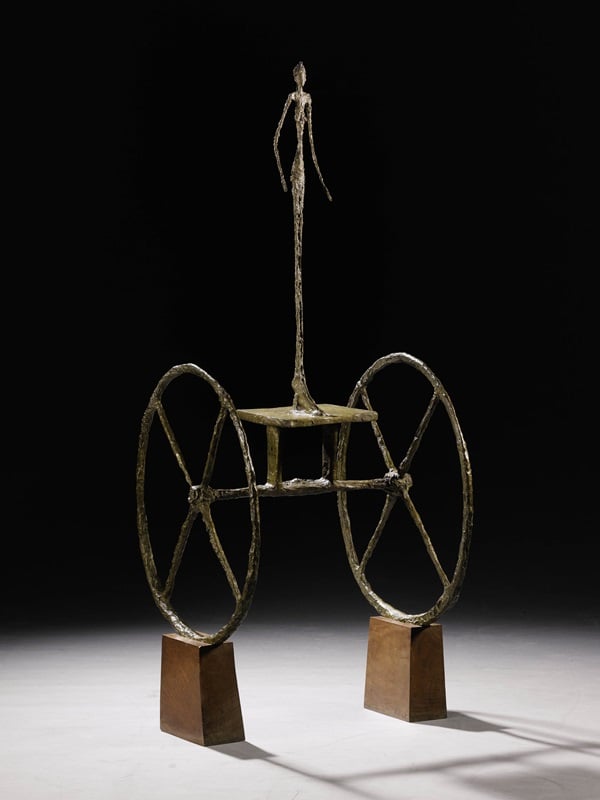
Alberto Giacometti, Chariot, conceived in 1950 and cast in 1951–52. Courtesy Sotheby’s.
The foundation also works with two galleries: Gagosian and Paris-based Kamel Menour.
In February 2010, Giacometti became the first sculptor to break the $100 million mark at auction, when L’homme qui marche I (1960) sold for £65 million ($103.9 million). That sale marked something of a tipping point for the sculpture market and certainly for the artist. Prior to that, according to the artnet Price Database, the highest Giacometti sculpture price was $27.5 million, paid at Christie’s New York in May 2008 for Grande femme debout II (1959-60).
Now, major Giacometti works regularly fetch eight figures at auction. At its upcoming London Impressionist and Modern art sale on June 21, Sotheby’s will offer Grande Figure (1947) a unique, gold-painted sculpture that carries an estimate of £15 million–25 million ($19 million–32 million). Sotheby’s said the sculpture, which is over three feet tall, “marks the beginning of the most significant period” in Giacometti’s career, the same year he created L’Homme qui marche and L’Homme au doigt. Last month at Christie’s, a circa 1957 bust of Diego, one of six, sold for $10.9 million on an estimate of $10 million to $15 million.
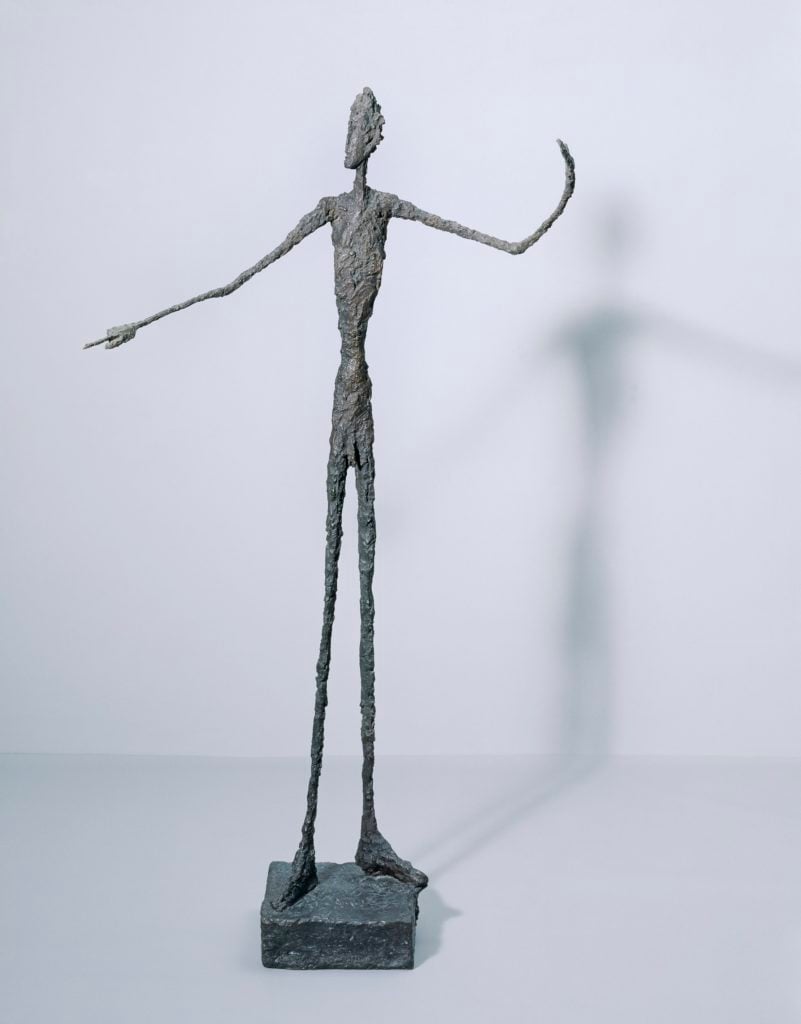
Alberto Giacometti’s Man Pointing (1947). Image courtesy of Tate.
© Alberto Giacometti Estate, ACS/DACS, 2017.
Sculpture on the Rise
Beyond careful estate management, Giacometti has been the beneficiary of broader market shifts. Within the past decade, collectors have been increasingly willing to spend big bucks on sculpture.
The medium was long considered “lesser,” points out David Norman, a private dealer and former longtime co-head of Sotheby’s Impressionist and Modern department. Norman says that a version of Chariot, a Giacometti sculpture that sold for $101 million in 2014, was sold at Sotheby’s in the early 1980s for roughly $1.4 million, one of the highest prices for sculpture at the time. Meanwhile, Impressionist paintings were already regularly fetching prices in the tens of millions by 1990.
There has been “a remarkable catch-up in how a masterpiece sculpture is priced versus a masterpiece painting,” says Norman, who handled the winning—albeit single—bid for the buyer of Chariot, later revealed to be mega-collector and hedge fund titan Steve Cohen. It remains the third-highest price for a Giacometti sculpture to date, after L’homme au doigt or Pointing Man (1947) also bought by Cohen, for $141.3 million at Christie’s in May 2015.
Collectors no longer discriminate against sculpture because it is essentially a “multiple” and not unique, Norman says. He attributes this in part to “an influx of hyper-wealthy bidders versus years past,” for whom uniqueness is perhaps less important than name recognition.
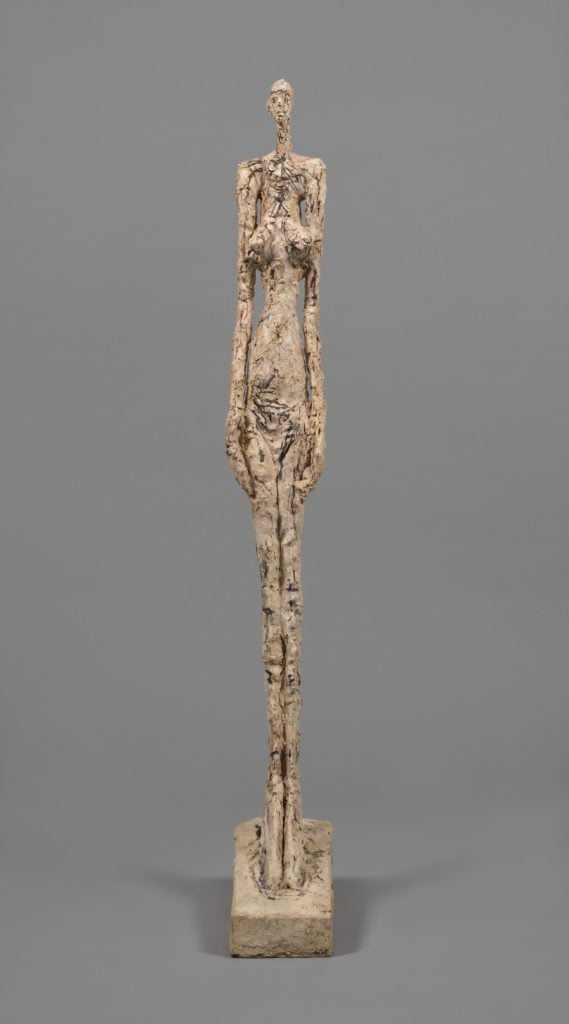
Alberto Giacometti’s Woman of Venice V (1956). Collection Fondation Alberto et Annette Giacometti, Paris, © Alberto Giacometti Estate, ACS/DACS, 2017.
Changing Attitudes Toward Authorship
In recent years, Giacometti’s market has also reflected evolving perceptions about the value of posthumous casts. After Giacometti died in 1966, his brother Diego continued—as is authorized under French law—to make bronze casts up until his death in 1985. His wife Annette also oversaw some posthumous casts.
Diego played an essential role in his brother’s practice, making the supporting frameworks and molds for the sculpture, preparing and applying the patina for the bronze casts, and carving most of the sculptures in stone. James Lord once wrote that Diego’s contribution was the equivalent of giving Alberto “four hands.”
Given how closely the brothers collaborated with one another, it makes for “a different kind of posthumous,” says the dealer Nick Maclean. Years ago, Norman adds, “posthumous casts simply did not sell. But over the years, again with the sense that the market is seeking supply, posthumous casts were much more easily embraced.” He estimates that the price of a posthumous cast might run at perhaps 60 percent of the price of a lifetime cast though he notes that for a major subject the pricing gap tends to be wider.
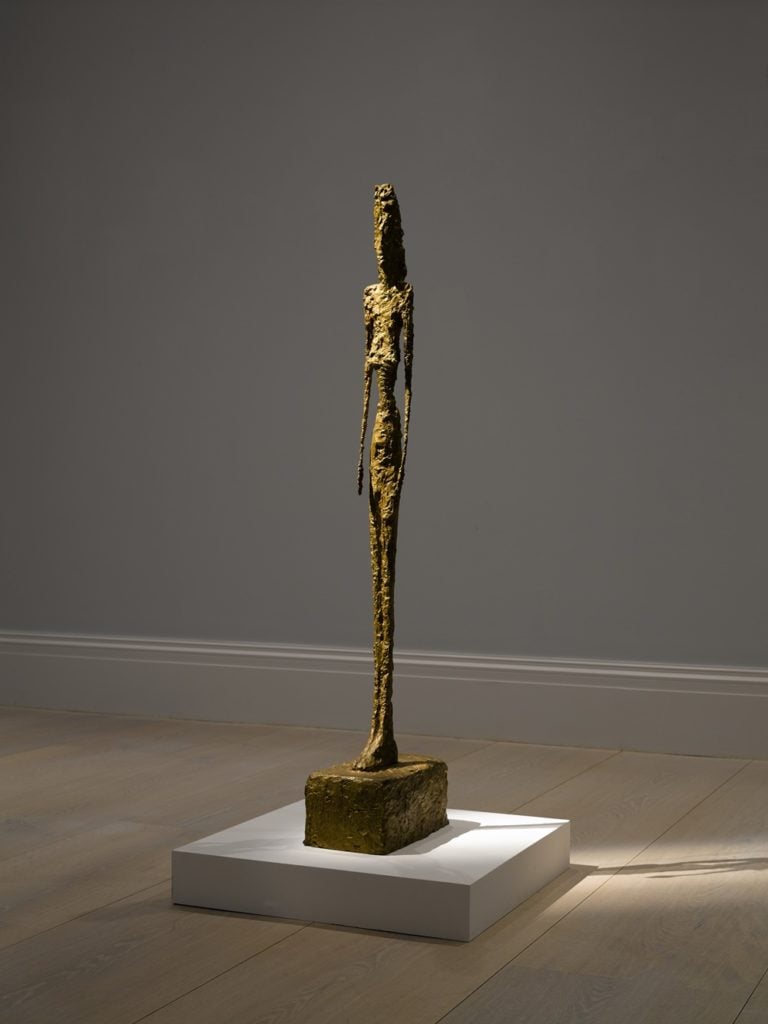
Alberto Giacometti, Grande Figure (1947). Courtesy Sotheby’s.
Price Progression
Maclean notes that beyond the headline-making figures, Giacometti’s market has been on a steady rise over the past few decades. “If you take those three highest prices out of the mix, the sculptures generally sell around the $50 million mark. There has not been a huge move in those prices,” he says.
According to the artnet Price Database (overlooking the three $100 million-plus results), two lots—both busts—have sold above $50 million at auction, one just above $30 million, four above $20 million, and 23 between $10 million and $20 million. Nearly 200 Giacometti works (188 in total) have sold at prices between $1 million to $10 million. In all, the artnet database lists close to 5,000 results for the artist.
Within Giacometti’s oeuvre, notes Maclean, “certain subjects are much more appealing.” Collectors have been particularly drawn to the emaciated, isolated human figures—walking men, falling men, standing women (albeit with a slight premium on male vs. female figures)—as well as busts and painted portraits of Diego, Annette, and sculptures of body parts such as an arm or elongated nose. “People tend to do their research,” Maclean adds, so rarity, paint, and patina, which can vary greatly from one object to the next, also come into play in determining a work’s desirability.
There are more than 540 known paintings, says Lecuyer (more than 100 belong to the foundation). She estimates there are more than 500 models of sculptures, many of which were produced in an edition of six, plus an artist’s proof or two. Experts say Diego sometimes denoted posthumous or later casts with a zero.
“Decorative and graphic arts—they are almost impossible to estimate,” she says. There are also several thousands of prints and drawings, including those in the collection of the foundation, which has the world’s largest holdings of works in the medium.
Of Giacometti’s enduring appeal, Simon Stock of Sotheby’s says, “I think he’s an artist who will stand the test of time because people are just fascinated by him. Although he was internationally famous, he didn’t seek fame. He went through different periods in his career, and he struggled, but he produced an extraordinary body of work… He was the consummate artist who was really obsessed by what he did and there is no sense that he did it for any other reason than to do his best.”